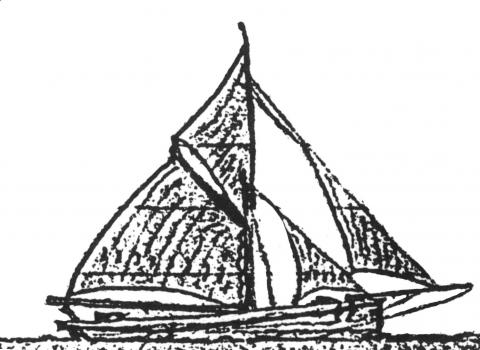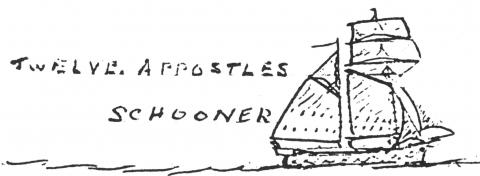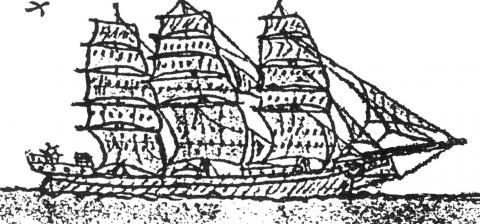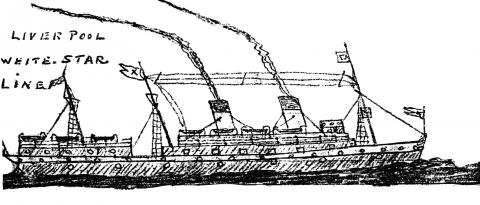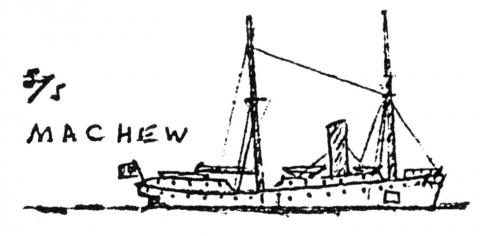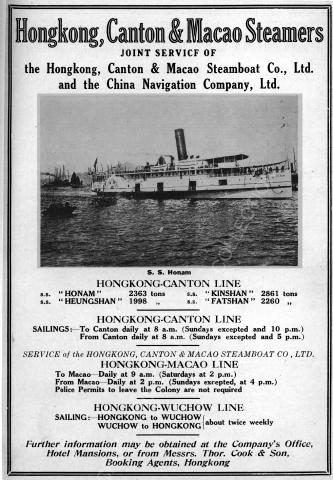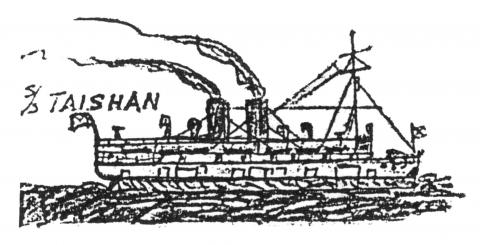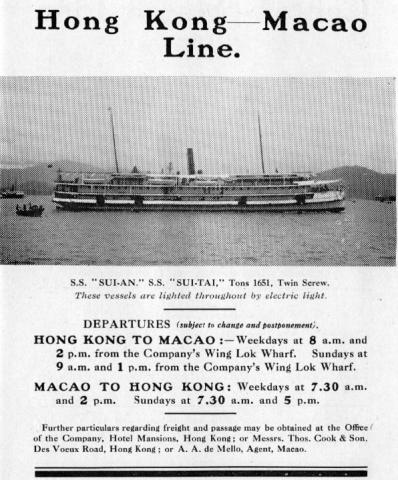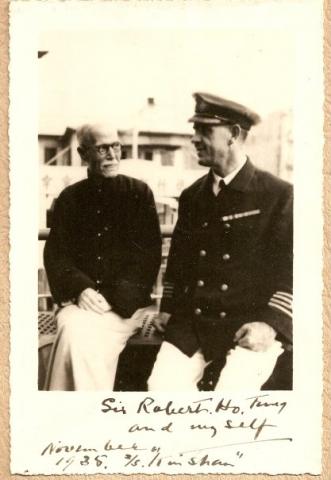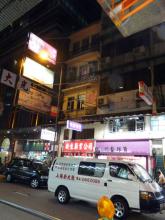I was 15 years old in the year 1893, a Farmer's son looking always away to sea watching the Portmadoc Schooners daily setting sail from Portmadoc. It was much against my father's and mother's will that I should take up the sea as a career, however I was bent on going and had made up my mind. So one fine afternoon Captain John Evans Gegin Abererch came to see me having heard that I wanted to go to sea (a strong boy). He offered me to go away with him in the Fishguard Lass - a small thing of about 60 to 80 tons, however I joined her at Portmadoc. Captain Evans, his son, and myself were all the crew. After being laid up at Portmadoc for six weeks we got a cargo of slates for Cardiff. We made a fairly good trip and safely arrived at Cardiff, discharged the cargo and loaded coal for Aberdaron, discharged there and sailed for Pwllheli at which place we arrived safely. At Cardiff I had a letter from my mother and never answered it - I distinctly remember her asking me when I got home why I did not reply to her letter, of course it was just thoughtlessness on my part.
I left the "Fishguard Lass" and joined a Schooner named "Twelve Apostles" under Captain Williams Clogwyn Bach - made a voyage to Statein Germany back to England and returned to Pwllheli. I rather think I made another voyage in the “Twelve Apostles".
Then went away in the full-rigged ship "Cambrian Monarch" under Captain John Richards a friend of my father's. I joined him in London docks (East India Dock I think) when I arrived in London and joined the ship. The Captain's wife was there.
We sailed for Melbourne Australia, with a general cargo for Melbourne and went to Geelong to load grain for Cape Town, from Cape Town sailed for Port Germain Australia ((StephenD: Port Germein)) and loaded grain for home (Europe), called at Queenstown for orders and safely arrived and got our orders for Limerick. After a long voyage, all the crew were paid off at Limerick and I went home for a holiday. I joined the Cambrian Monarch in Cardiff for my Second Voyage in her. There was a new mate and new Second mate but the same Captain, and Messrs Thomas Williams & Co, had been bought over by Messrs William Thomas & Co however everything seemed new again to me. This trip we loaded coal for Macassar Dutch East Indies we made a very long voyage out to Macassar. The voyage became very difficult towards the end of the voyage when we arrived among the Islands of Dutch E. Indies there were hurricane squalls and thunder storms N,W.monsoon. We finally got a Dutch warship to tow us in, we had coal for the Dutch Navy. We arrived there and discharged our own cargo in the sweltering heat and monsoon rain, when I caught malaria.
From Macassar we sailed for Newcastle New South Wales to load coal for Callao after waiting three months through a coal strike - during those three months some of the world's finest sailing ships were laid up there, never since did I see such a gathering of the world's finest sailing ships, namely, (some of them ) "King David" "Windermere" "Cape Clear" "Bendraggon Castle." "Rhyddlan Castle" " Cambrian Hills" "Kerchubreshire" ((StephenD: Kirkcudbrightshire)), "Loch Lomon". Several more that I cannot now bring back to mind, we sailed for Callao and arrived there safely, discharged our cargo, sailed for Talcuano ((StephenD: Talcahuano)) and loaded grain for home Queenstown for orders. Arrived after a long passage and got our orders for Fleetwood where we arrived safely - crew paid off and I went home for a holiday - after which I went to London to the Navigation School Captain Nicholas School in East India Road - King Ed,Nautical College - but found when I went to put my papers in to sit for exam I was several months short of time to allow me to sit for exam so I had to go to sea again. Left School and went home in a brig named the Fleetwing, got to P'madoc and left her.
Money was short by this time , however I had a friend Captain Jones "Eglwysfa", he got me a job in the Steamer "North Cambria" then at Barry Dock. Mostly Nevin people in this ship - we sailed for Gibraltar Coal cargo, from there to some place in Sweden to load iron ore from there to Newcastle where I left the ship and went to London to School again. Went up and passed after the 2nd try, went home then feeling a great man. I afterwards got in touch with Mr. Wm. Thomas through Colonel Lloyd Evans Broom Hall. I interviewed them so they offered me the Cambrian Monarch (2nd, Mate) on her return.
But in the meantime I went into their steamer "Hemisphere* to await the arrival of the “Cambrian Monarch". She, (C.Monarch) eventually arrived in Rotterdam where I joined her where I found there was a great objection on the mate's part to my coming there he said he would not carry me if he was going master. The reason why I found out - he wanted his Brother there instead, however when the ship arrived in Liverpool he had to leave the ship. I remained. A new Captain named Thomas (Sth. Wales), a new mate named Evan Owen from Pwllheli, his family I knew well and between the two of them (Captain & mate) the treatment I received from them was not too nice until they fell out with one another on the way home. At Liverpool we loaded general cargo for Melbourne discharged the cargo and went to Newcastle Australia to load coal for Valparaiso, arrived safely there and loaded Saltpetre at Caleto Bueno ((StephenD: Caleta Bueno)). Sailed for Queenstown for orders, arrived at Qstown and got orders for Ostend Belgium discharged and left Ostend for Barry dock. Arrived there safely and I left for home.
After a short holiday went to London to School and passed for 1st. mate in about 4 weeks. Then reported myself ready for duty to Messrs. Wm. Thomas & Co, Liverpool and was appointed 2nd. mate to the full rig ship “Boadicea" and to join her at Hamburg.
I arrived at Hamburg and found there was already a Captain and mate already standing by the ship. The ship was towed from Hamburg to Cardiff but after towing for a couple of days the tug's funnel broke and rolled over the side - (name of tug, Sir John Lewis) there was nothing we could do but set sail and let go the tug which was useless to us. Captain's wife was on board. Captain R. Roberts belonging to Conway - we loaded for Cape Town (time Boar War 1901 -). From Cape Town to Newcastle New South Wales loaded coal for Valparaiso sailed from Valparaiso to Pugets Sound Seattle loaded grain Queenstown for orders - 5 months homeward passage - orders for Cardiff, (I left and went home and went to London passed for master -this story is written later -)
